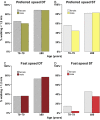Older adults must hurry at pedestrian lights! A cross-sectional analysis of preferred and fast walking speed under single- and dual-task conditions
- PMID: 28759587
- PMCID: PMC5536437
- DOI: 10.1371/journal.pone.0182180
Older adults must hurry at pedestrian lights! A cross-sectional analysis of preferred and fast walking speed under single- and dual-task conditions
Abstract
Slow walking speed is strongly associated with adverse health outcomes, including cognitive impairment, in the older population. Moreover, adequate walking speed is crucial to maintain older pedestrians' mobility and safety in urban areas. This study aimed to identify the proportion of Swiss older adults that didn't reach 1.2 m/s, which reflects the requirements to cross streets within the green-yellow phase of pedestrian lights, when walking fast under cognitive challenge. A convenience sample, including 120 older women (65%) and men, was recruited from the community (88%) and from senior residences and divided into groups of 70-79 years (n = 59, 74.8 ± 0.4 y; mean ± SD) and ≥80 years (n = 61, 85.5 ± 0.5 y). Steady state walking speed was assessed under single- and dual-task conditions at preferred and fast walking speed. Additionally, functional lower extremity strength (5-chair-rises test), subjective health rating, and retrospective estimates of fall frequency were recorded. Results showed that 35.6% of the younger and 73.8% of the older participants were not able to walk faster than 1.2 m/s under the fast dual-task walking condition. Fast dual-task walking speed was higher compared to the preferred speed single- and dual-task conditions (all p < .05, r = .31 to .48). Average preferred single-task walking speed was 1.19 ± 0.24 m/s (70-79 y) and 0.94 ± 0.27 m/s (≥80 y), respectively, and correlated with performance in the 5-chair-rises test (rs = -.49, p < .001), subjective health (τ = .27, p < .001), and fall frequency (τ = -.23, p = .002). We conclude that the fitness status of many older people is inadequate to safely cross streets at pedestrian lights and maintain mobility in the community's daily life in urban areas. Consequently, training measures to improve the older population's cognitive and physical fitness should be promoted to enhance walking speed and safety of older pedestrians.
Conflict of interest statement
Figures



Similar articles
-
Cognitive and motor mechanisms underlying older adults' ability to divide attention while walking.Phys Ther. 2011 Jul;91(7):1039-50. doi: 10.2522/ptj.20100114. Epub 2011 Apr 28. Phys Ther. 2011. PMID: 21527384
-
Are elderly pedestrians allowed enough time at pedestrian crossings in Cape Town, South Africa?Physiother Theory Pract. 2007 Nov-Dec;23(6):325-32. doi: 10.1080/09593980701593755. Physiother Theory Pract. 2007. PMID: 18075906 Clinical Trial.
-
Usual and Dual-Task Walking Speed: Implications for Pedestrians Crossing the Road.J Aging Health. 2016 Aug;28(5):850-62. doi: 10.1177/0898264315614004. Epub 2015 Nov 17. J Aging Health. 2016. PMID: 26578545
-
Review of safety and mobility issues among older pedestrians.Accid Anal Prev. 2016 Jun;91:24-35. doi: 10.1016/j.aap.2016.02.031. Epub 2016 Mar 4. Accid Anal Prev. 2016. PMID: 26950033 Review.
-
Dual-task exercises in older adults: A structured review of current literature.J Frailty Sarcopenia Falls. 2020 Jun 1;5(2):31-37. doi: 10.22540/JFSF-05-031. eCollection 2020 Jun. J Frailty Sarcopenia Falls. 2020. PMID: 32510028 Free PMC article. Review.
Cited by
-
Screening older adults for amnestic mild cognitive impairment and early-stage Alzheimer's disease using upper-extremity dual-tasking.Sci Rep. 2019 Jul 29;9(1):10911. doi: 10.1038/s41598-019-46925-y. Sci Rep. 2019. PMID: 31358792 Free PMC article.
-
Gait Speed with Anti-Slip Devices on Icy Pedestrian Crossings Relate to Perceived Fall-Risk and Balance.Int J Environ Res Public Health. 2019 Jul 10;16(14):2451. doi: 10.3390/ijerph16142451. Int J Environ Res Public Health. 2019. PMID: 31295887 Free PMC article. Clinical Trial.
-
Abnormal gait pattern emerges during curved trajectories in high-functioning Parkinsonian patients walking in line at normal speed.PLoS One. 2018 May 11;13(5):e0197264. doi: 10.1371/journal.pone.0197264. eCollection 2018. PLoS One. 2018. PMID: 29750815 Free PMC article.
-
Increased Likelihood of Falling in Older Cannabis Users vs. Non-Users.Brain Sci. 2021 Jan 21;11(2):134. doi: 10.3390/brainsci11020134. Brain Sci. 2021. PMID: 33494171 Free PMC article.
-
Why Are Older Adults More at Risk as Pedestrians? A Systematic Review.Hum Factors. 2022 Dec;64(8):1269-1291. doi: 10.1177/0018720821989511. Epub 2021 Feb 8. Hum Factors. 2022. PMID: 33555944 Free PMC article.
References
-
- Liu B, Hu X, Zhang Q, Fan Y, Li J, Zou R, et al. Usual walking speed and all-cause mortality risk in older people: A systematic review and meta-analysis. Gait Posture. 2016;44: 172–7. doi: 10.1016/j.gaitpost.2015.12.008 - DOI - PubMed
-
- Abellan van Kan G, Rolland Y, Andrieu S, Bauer J, Beauchet O, Bonnefoy M, et al. Gait speed at usual pace as a predictor of adverse outcomes in community-dwelling older people an International Academy on Nutrition and Aging (IANA) Task Force. J Nutr Health Aging. 2009;13(10): 881–9. - PubMed
-
- Fritz S, Lusardi M. White paper: "walking speed: the sixth vital sign". J Geriatr Phys Ther. 2009;32(2): 46–9. - PubMed
-
- Studenski S. Bradypedia: is gait speed ready for clinical use? J Nutr Health Aging. 2009;13(10): 878–80. - PubMed
-
- Turner G, Clegg A, British Geriatrics S, Age UK, Royal College of General P. Best practice guidelines for the management of frailty: a British Geriatrics Society, Age UK and Royal College of General Practitioners report. Age Ageing. 2014;43(6): 744–7. doi: 10.1093/ageing/afu138 - DOI - PubMed
MeSH terms
LinkOut - more resources
Full Text Sources
Other Literature Sources
Medical

